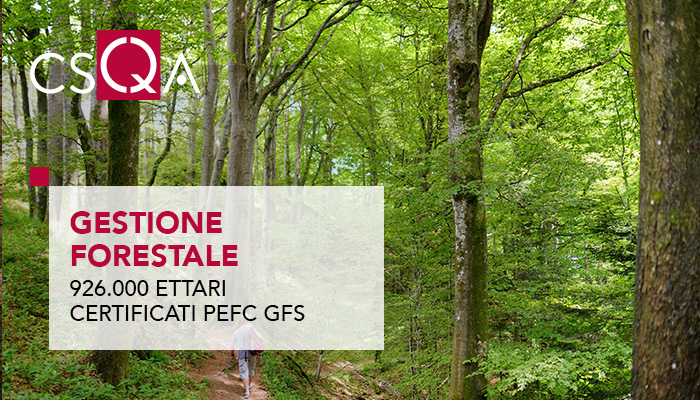
In Italy, the area certified for PEFC sustainable forest management reaches 925,609.96 hectares , demonstrating the growing interest and attention of forest managers to environmental and sustainability issues.
The latest entries concern Central Italy.
In Tuscany , the Unione dei Comuni Montani del Casentino (AR) has obtained from CSQA the acknowledgment of the certification of 5,764.57 hectares of beech woods, chestnut woods, Turkey oak woods, downy oak woods, oyster woods, fir woods, Douglas fir trees, black pine woods, plants of minor non-spontaneous species, post-culture shrubs, for the sale of standing lots and stacked assortments. Owned by the Region and managed since 1977, the forest system extends from Monte Falterona along the Tuscan-Romagnolo Apennines to the Mandrioli Pass and includes part of the Camaldoli and Badia Prataglia Forests.
In the Marches , the Agricultural-Forestry Company for the management of agro-forestry-pastoral assets of the Marches - PEFC Bosco di Marca Group, of Fabriano (AN), has certified, after the CSQA control, 9,208.25 hectares of reforestation of conifers, beech woods, mixed broad-leaved woods, chestnuts, oaks, holm oaks. It is a group certification in which, in addition to the lead company, three other realities took part: the Agricultural-Forestry Company for the management of agro-forestry-pastoral assets of the Monti Azzurri, the Agricultural-Forestry Company for the management of agro-forestry-pastoral assets of Tronto, and the Special Consortium Company of Catria.
A weapon against climate change
Forests have the ability to sequester atmospheric carbon and store it in biomass . This feature is influenced by the ongoing climate change . An international team led by Daniela Dalmonech, research fellow at the Forest Modeling Lab at the Institute for Mediterranean Agricultural and Forestry Systems of the National Research Council (Cnr-Isafom) of Perugia , seeks to shed light on the possible future of European forests and on the role of forest management in contrasting the effects of climate change, analyzed with a modeling approach.The results, obtained using a forest biogeochemical model applied to different silvicultural and climatic management scenarios, are described in two studies published in the journals Science of the Total Environment and Agricultural and Forest Meteorology. "Both studies analyze different forest management scenarios, focusing on the possibility of managing forests more or less intensely - and differently - starting from the present and until the end of the century", says Daniela Dalmonech , "forests are in fact able to absorb and store carbon in their tissues depending on how we decide to manage them".
In the first study, published in the journal Science of the Total Environment , the analysis of six different forest management scenarios, including one in which the forest is left to "natural" evolution, focused on the experimental site of the Bonis basin in Calabria , one of the southernmost artificial larch pine plantations in Europe. Forests this far south already show a high susceptibility to extreme events due to climate change. Different interventions, based on varying the intensity and the time between one cut and the next, make it possible to act significantly on the carbon sequestration potential of these heavily man-made ecosystems, reducing, for example, competition between individuals and increasing the availability of water and light for the remaining ones.
"Our results" explains Dalmonech "show how intervention cycles that favor treatment with subsequent cuts represent a good compromise that allows minimizing any reductions in carbon sequestration capacity in the long term caused by the impact of climate change, while supporting and increasing wood production at the same time (well over 40% ), while non-management turns out to be in some cases the worst option both in terms of sequestration capacity and biomass accumulation".
In the second study, published in the journal Agricultural and Forest Meteorology, the researchers asked whether an increase (or decrease) in the intensity and frequency of felling, compared to current practices, could automatically increase the ability of forests to sequester and store atmospheric CO2.
"The investigation took place through a modeling approach applied to central-northern European forests under four different climate change scenarios", explains Gina Marano . "About twenty different scenarios were compared with higher and lower intensity and frequency of harvesting compared to common management practices. The results produced by the model show how correct forest management leads to an improvement, both in terms of carbon sequestration and storage, also for the future, regardless of the climate scenario considered".
Alessio Collalti, head of the Forest Modeling Laboratory and co-author and coordinator of both works, concludes: "Our results also show how forest management, and the type of management that is decided to be applied in the medium and long term, has by far a greater impact than climate change itself. It is therefore important to carefully analyze each individual case. The hope is that both of our studies will stimulate the ongoing debate on adaptation, mitigation and decarbonization strategies based on forest resources, in Italy as in Europe. Non-management certainly remains an option, but managed forests can help us further reduce atmospheric CO2 and therefore the effects of ongoing climate change". (Source: http://www.parks.it/ )